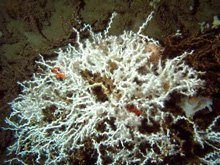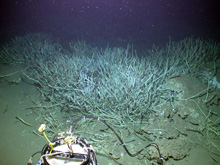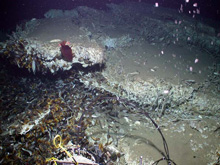This small thicket of live Lophelia pertusa, which researchers observed on the Gulf of Mexico's upper slope, contains a number of visible associated animals, including galatheid crabs, sea urchins, and sea lilies. Click image for larger view and image credit.
This large aggregation of Escarpia laminata tubeworms is attached to an uplifted carbonate block at 2,200 m depth in Alaminos Canyon. Note the Bushmaster collection device (in the foreground), which is attached to the front of the deep submergence vessel Alvin (not shown). Click image for larger view and image credit.
The Ecology of Gulf of Mexico Deep-sea Hardground Communities
Erik E. CordesHarvard University
The main focus of Expedition to the Deep Slope is to better understand the distribution and biology of the organisms living on hydrocarbon seeps and rocky substrates in water depths greater than 1,000 m (3,280 ft). The rocky substrates, or hardgrounds, are usually found in association with cold seeps because most of the hardgrounds are a by-product of the breakdown of oil and gas by microbes. There are two broad categories of communities inhabiting these deep-water hardgrounds in the Gulf of Mexico. The first are the chemosynthetic communities, which derive their energy from chemosynthesis rather than photosynthesis. The second are deep-sea coral communities, thought to rely on hardgrounds as a place to settle and grow above the surrounding muddy bottom.
Tubeworms
Tubeworms and mussels dominate the chemosynthetic (able to derive energy from chemical reactions vs. sunlight) communities in the deep Gulf of Mexico. Both of these animals use chemosynthetic bacteria as their source of energy. They do not feed on bacteria in the environment (like many of the other inhabitants of the seeps), but rather house them within their bodies as internal symbionts (organisms that live together). Tubeworms are commonly referred to as vestimentiferans; however, they have recently been placed in the family Siboglinidae within the polychaete annelids or marine bristle worms. All vestimentiferans lack a digestive tract as adults, i.e., they have no mouth or gut. Instead, they are completely dependent on symbiotic, sulfide-oxidizing bacteria housed in a large internal organ: the trophosome, which literally means “feeding body."
One of the things we are interested in is how these tubeworms take up sulfide to supply to the bacteria. Riftia pacyptila, the giant tubeworm that lives at hydrothermal vents, takes up hydrogen sulfide through its gills, or plume, from the warm venting fluids. One of the species of tubeworms found at shallower (less than 1,000 m deep) areas of the upper slope in the Gulf of Mexico, Lamellibrachia luymesi, takes up sulfide through a “root-like” part of its body that is buried in the sediment. It is not known whether the deeper living species take up sulfide in this same manner. In fact, only a single species of tubeworm from below 1,000 m in the Gulf of Mexico has even been named, Escarpia laminata, although we believe there are at least one or two additional species present at these depths.
This bed of mussels (Bathymodiolus childressi), located beneath a carbonate ledge, shows tubeworms sticking up through cracks in the carbonate at 2,200 m depth in Alaminos Canyon. Note the sea cucumber swimming away after being disturbed by the submersible. Click image for larger view and image credit.
Mussels
Cold-seep mussels also have symbionts and rely on them for most of their nutrition. However, unlike the tubeworms, mussels have not completely lost their mouth and gut. Different types of mussel symbionts can use either methane or hydrogen sulfide as their energy source. Some mussels have more than one type of symbiont, and can therefore get nutrition from both energy sources. There are three known mussel species from the deep Gulf of Mexico seeps. The first is Bathymodiolus childressi, a mussel with methane-oxidizing symbionts. This species of mussel was originally found at the shallow-water seeps in the Gulf of Mexico, but has since been discovered in deeper water, at 2,200 m in Alaminos Canyon. It is one of the only species confirmed to live at both the shallow and deep seeps in the Gulf of Mexico. Bathymodiolus brooksi contains both methane- and sulfide-oxidizing symbionts, and therefore can use either type of chemical for energy. This species has been found from 1,890 to 3,300 m depths in the Gulf. The third described species of mussel in the deep Gulf is Bathymodiolus heckerae, which also possesses both types of symbionts. This species has been reported only from the Florida Escarpment site at 3,300 m, but we may find it during our explorations in this depth range in the western Gulf.
Clams
A third group of organisms that can dominate some seep habitats are vesicomyid clams that contain sulfide-oxidizing symbionts. Although two species have been described on the upper slope, they are usually found as single individuals at the end of long trails in the mud — the evidence of their continuing search for the sulfide they require. At many other seep sites around the world this type of clam occurs in large beds of hundreds to thousands of individuals. Such an aggregation was spotted as submarine left the bottom at the very end of the last dive of a cruise in the deep Gulf of Mexico in 1990. Those clams are probably a new species, but have never been collected. We hope to find large aggregations of clams on this voyage so we can learn more about the species and their role in this habitat.
Associated Communities
The symbiotic tubeworms, mussels, and clams are the foundation species of cold seeps and hydrothermal vents around the world. They function as the trees in a forest or the corals on a reef by constructing habitat that supports many other species. Species commonly associated with these foundation species include limpets, starfish, shrimp, crabs, snails, fish, and numerous species of polychaete worms. In the deep Gulf of Mexico, we have obtained only a limited number of collections, and we expect to find many more species and possibly whole new types of communities during this study. Much more is known about the upper-slope seep sites, and we can make some predictions about the deeper seeps, based on our knowledge of the upper-slope seep sites.
One of the things we are interested in understanding is succession in these deep-sea communities. Succession is the process of replacement of one type of community with another. For example, consider the patterns of succession in a forest that forms from an old field. At first, the field consists of different grasses and other short-lived but fast-growing species. Over time, small shrubs and short trees move in and begin to take over. Eventually, large, long-lived trees dominate the forest and shade out many of the earlier species that came into the field.
The same process happens in the seep environment. Mussels colonize sites of active seepage where concentrations of methane and sulfide can be quite high. The communities of organisms associated with mussel beds are often dominated by endemic species — those species that are only found at seeps. The endemic species are typically more likely to be able to tolerate the high concentrations of toxic methane and sulfide and are therefore better able to survive, feeding on free-living bacterial communities at the seeps. As seepage rates decline, tubeworms begin to colonize and take over old mussel beds. Both mussel beds and young tubeworm aggregations contain large numbers of individuals, because the high biomass of bacteria can support a lot of different animals feeding on them. As the tubeworm aggregations age, they are colonized by more and more non-endemic (non-native) species from the background deep-sea communities. At first, these two groups of organisms co-exist to form the highest diversity communities, but in later stages the non-endemic species begin to dominate the community. In these later stages, there are usually low numbers of species and individuals, probably just using the tubeworms as shelter and feeding in the surrounding area.
Corals
Hydrocarbon seeps do not last forever. When the seepage eventually resides, the animal communities dependent on the chemicals die off. Only the carbonate rock deposited during times of high seepage rates remains (see Geology essay). These hardgrounds are colonized by deep-sea corals, and could be considered the final successional stage of a seep community. Deep-sea corals are considered predators, capturing tiny zooplankton and other materials with their polyps. Coral communities consist of sea fans (gorgonians), soft corals, black corals, bamboo corals, and the “true” hard corals (scleractinians). The most well-known deep-sea coral is Lophelia pertusa, which is a scleractinian that forms large reefs found at depths greater than approximately 300 m in the Gulf of Mexico. We do not yet know the full depth range of Lophelia in the Gulf, although it has been found as deep as 3,000 m in some places in the Atlantic.
All these coral types create complex habitat on the hardgrounds of the deep Gulf. The hardgrounds are colonized by associated communities much in the same way as tubeworms form aggregations. There are a few species in common between the tubeworm and coral communities, but the corals are colonized mainly by the background fauna of the deep sea. On the upper slope, there are also a few coral-endemic species (those species that live only on coral), including a small coral-feeding snail (Coralliophila) and a polychaete that bores into the coral skeleton (Eunice). Whether these species will be found with the deeper-water corals is still unknown. We are certainly excited to see what we find.































